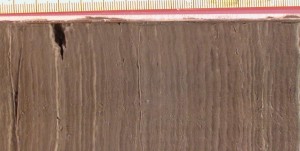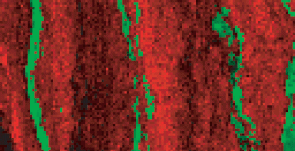Research
Opportunities
Check back soon or feel free to contact me about opportunities for graduate and undergraduate researchers in the Shanahan lab.
High resolution paleclimate reconstructions from varved sediments
Acquiring high-resolution records of past climate changes is difficult because few geological archives preserve an annual signal; most high resolution records come from biological archives like corals and tree rings. A less commonly utilized archive of high-resolution paleoclimate information is annually laminated or varved lake sediments. New tools like scanning XRF analysis and advances in digital image processing offer opportunities for developing annually-resolved records from varved lake sediments. When comparisons with instrumental climate data allow for the quantification of varve-climate relationships, and when used in conjunction with lower reolution geochmical data (i.e., stable isotopes) they can provide valuable records of past climate variability, particularly when examining the rates and timing of abrupt changes. Furthermore, our group has identified varved lake records in nearly every region we have visited, suggesting that varved lakes are much more common than previously assumed.
|
|
|
Molecular paleoclimatology
Our laboratory uses a variety of techniques focused on the structural and stable isotope characterization of molecular “biomarkers” as proxies for past climate change. This approach is based upon the idea that certain organic molecules are diagnostic of specific organisms and as a result, can be interpreted as source specific. The stable isotope analysis of these compounds is thus much better constrained than traditional approaches examining the isotope composition of bulk organic matter. Other techniques rely on changes in changes in the relative abundance or structural makeup of certain biomarkers as indicators of changing productivity or environmental conditions. More details on some of the approaches used in my lab is provided below:
Isotope analysis of leaf waxes
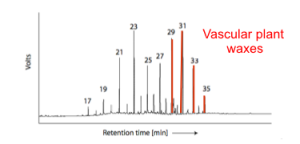 |
The stable carbon and hydrogen isotope composition of leaf waxes provides a record of past vegetation type (C3 vs C4 plants) and paleohydrology. We have several projects using hydrogen and carbon isotopes to reconstruct changes in vegetation cover and hydrology in Africa, South America and the southwest US, and are currently involved in projects examining the apparent hydrogen isotope fractionation between leaf waxes and source water. |
GDGTs
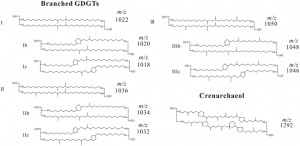 |
The GDGTs (glycerol diakyl glycerol tetraethers) are membrane lipids produced by the Archaea and an as of yet unidentified type of acidobacteria that show a strong empirical relationship with temperature. Our group is currently working on several calibration projects to improve our understanding of the relationships between branched GDGTs and temperature in both soils and lake sediments, and we are using these methods to generate new paleotemperature reconstructions at numerous locations and over a range of timescales. |
Other biomarkers
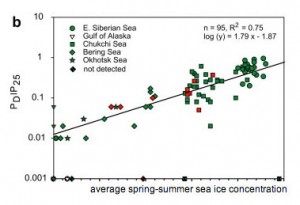 |
There exist a vast diversity of biomarkers in the natural environment with the potential for the development of new biomarker-based paleoclimate proxy indicators. In my laboratory, the primary focus is using these approaches, where possible, to answer interesting and unanswered questions in paleoclimate. For example, we are currently working on the application of the IP25 sea ice proxy for the reconstruction of paleosea ice cover in the Arctic ( figure). We expect that the number and diversity of paleoenvironmental conditions that can be reconstructed using these approaches will continue to evolve, making this an active and exciting field of research into the future. |

